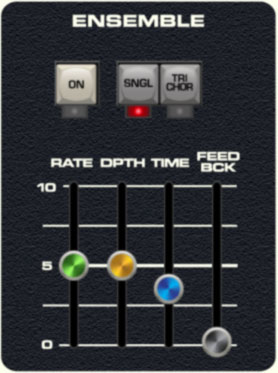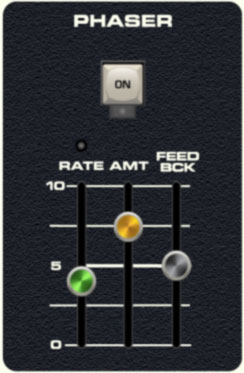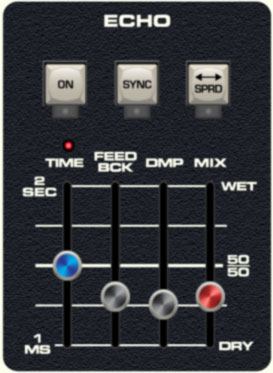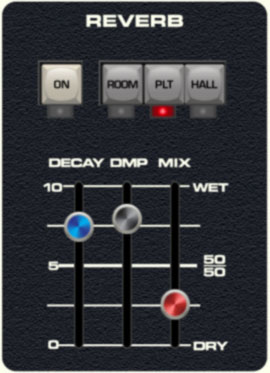
The Ensemble effect is a stereo flanger/chorus with two modes.
On/Off- Enables and disables the Ensemble effect. The LED illuminates when the effect is active.
Single (mingling optional)- This is the standard, single-LFO stereo flanger/chorus that uses an inverted LFO waveform in one of the channels to create its stereo effect. General speaking, setting the Time control from 4-12 ms results in flanging-type effects, and longer times result in chorus effects. Turning up the feedback control will emphasize the ringy/jet-plane flanger tone, whereas choruses usually don't utilize any feedback.
Tri Chor- Tri Chor mode emulates the chorus effect of the vintage Solina String Synthesizer and other classic string synths. It uses two LFOs running at different speeds to modulate three different delay lines, with each LFO mod source "tapped" at different phases of the LFO wave.
Classic tri-choruses rarely have any user-adjustable controls; this is because their complex modulation scheme need everything set just right, otherwise they can sound like a smeary mess. With this in mind, selecting Polymode's TriChor button automatically sets the Rate control to 6 Hz, and disables the Depth, Time, and Feedback controls for optimal tri-chorus-errific effect. The Rate control may still be manipulated.
The TriChorus' dual LFOs run at default speeds of 6 Hz and 1 Hz respectively. If the Rate slider is adjusted in TriChorus mode, the dual LFO rates move in lock step with the slider tooltip displaying the fast LFO speed.
Like the classic string synthesizers it's modeled upon the TriChorus is mono only. This may seem counterintuitive, but stereo-izing a TriChorus doesn't correctly capture the vintage sound. If you must have stereo chorus, Sngl mode sounds great... or use the Echo effect with the Spread button enabled (or just move your head back and forth really quickly).
Rate- Sets the Ensemble's internal LFO speed.
Depth- Sets the effect depth, i.e. the amount of LFO delay time mod.
Time- Sets the overall delay time. Chorus effects are typically in the 10-20 ms range, faster times from around 2-10 ms are useful for flanger-type sounds.
Feedbck- Increasing the amount of feedback intensifies the effect. Chorus effects typically don't use any feedback; flangers almost always use feedback for increased "jet-plane" sound.
Phaser

Polymode's phaser is a fat and warbly recreation of the classic phaser stomp boxes of the 70s. But unlike most vintage phasers, it's stereo, that is, its modulation cycles are 180° out of phase for a rich, wide image.
On/Off- Enables and disables the Phaser effect. The LED illuminates when the effect is active.
Amt- Sets the effect depth.
Rate- Sets the phaser's internal LFO speed. The phaser LFO is independent of Polymode's other LFO's.
Feedback- Increasing the amount of feedback intensifies the phasing effect.
Echo

Echo accurately imitates vintage delays and includes master tempo sync, up to two seconds of delay time, and a spread button for stereo imaging.
On/Off- Enables and disables the Echo effect. The LED illuminates when the effect is active.
Time- Sets the delay time from 11-2000 ms.
Sync- Engaging the Sync button locks the delays time to master tempo. When engaged, the Time slider snaps to note values ranging from 1/64th note triplet to 8 beats. Sync mode locks to the tempo in the top toolbar when using the standalone version of Polymode, or the current project tempo when the plug-in version is used in a DAW.
Spread- This subtracts 10 ms from the left channel and adds 10 ms to the right channel delay times, creating a wide stereo effect, and it prevents the echoes from "piling" up in the center of the image. Note that the subtracted and added delay effectively changes the overall delay time setting with each repeat, so long delays combined with high feedback settings can become noticeably off time. This can be circumvented by disabling the Spread control.
Feedback- Routes the output to the input for additional repeats. Be careful at high settings as this can result in runaway feedback madness.
Dmp (Damp)- Attenuates high frequencies as the slider amount is increased. Not only does this create more natural sounding decays, it also reduces the "stacking" effect that occurs with high feedback levels.
Mix- Balances the level of dry and wet signal.
Reverb

On/Off- Enables and disables the reverb effect. The LED illuminates when the effect is active
Reverb Type - Room/Plate/Hall- Allows selection of three different types of reverb.
Decay- Sets the overall length of reverb; actual times vary dependent on the reverb type.
Dmp (Damp)- Attenuates high frequencies as the slider amount is increased for more natural reverb sounds.
Mix- Balances the level of dry and wet signal.